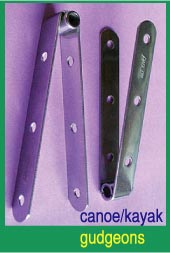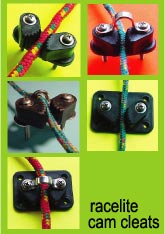| Jim, a friend of mine who lives in
southeastern Wisconsin, built this beautiful Chesapeake Light
Craft (CLC) Passagemaker design during 2009. This is
his first boat.
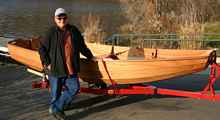 |
Proud owner with his new Chesapeake Light Craft
Passagemaker on the ramp before launching |
The CLC Passagemaker is a Norwegian-style pram that
is built from a stitch and glue kit. Prams have transoms fore
and aft. This design is 11 feet 7 inches long, 56 inches wide,
and weighs in at 90 pounds. It is designed to carry three people
and gear, for a total combined weight of 650 pounds, and can be
motored or sailed.
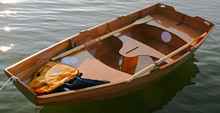 |
A practical, beautiful small craft |
Jim picked the CLC Passagemaker because he already had
a canoe and really didn’t want to build a kayak. His intention
was to look for something that was "different", a boat
that was something not routinely seen inland around southeastern
Wisconsin.
“The sailing aspect of this boat is what really captured
my imagination!” he states, emphatically. “I wanted
a boat that I could share with my spouse as well as the rest of
the family. I knew I could always go out in my solo canoe but
I really wanted something that would be fun to do solo or with
family and friends.”
 |
Jim takes his Passagemaker out for
a row |
Jim is fortunate that the Rock River Canoe Company, run by owner
Kim Grunow, is located nearby on Main Street in Fort Atkinson
WI. https://rockrivercanoe.com/
After some preliminary discussion about his skill level and the
type of boat he wanted, Kim suggested that he consider the wide
range of Chesapeake Light Craft (CLC) designs. https://www.clcboats.com/
.
Jim looked over the various CLC boats and kayaks and fell hard
for the Passagemaker, saying “There is nothing
else out there like this boat. It was love at first sight and
I really can't rationally explain why this was THE boat. It just
fit all the criteria that I had hoped for in a boat. Within days
I ordered the kit and was off on a wonderful experience.”
Jim had the CLC kit shipped to the Rock River Canoe Company and
waited impatiently until shop space became available.
Cheapeake Light Craft says “Stitch-and-glue construction,
along with the development of epoxy and modern mahogany marine
plywood, has revolutionized and revitalized wooden boat building.
This method of building is not only stronger, lighter, and faster
than traditional wooden boat building, but it also takes far less
skill. With stitch-and-glue construction, no strongbacks, forms,
or temporary frames are required to build the boats.”
“Although I was a novice woodworker”, Jim said, “I
found the kit and instructions very doable. Kim Grunow really
didn’t help too much other than providing the shop space
and being a constant source of encouragement. Things just really
fell together well as a result of a very well put-together kit.
In addition to the excellent instruction manual, there is an online
bulletin board at the CLC website where others have documented
their experiences while constructing the Passagemaker.
Knowing that others had overcome the various problems I encountered
was an empowering experience. I knew, even with my minimal experience,
that what I was going through was no different than what anyone
would during the course of construction.”
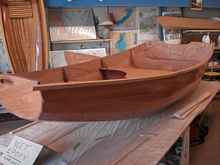 |
Jim’s Passagemaker under construction
at the Rock River Canoe Company |
Stitch and glue kit boats from CLC come with all material, including
epoxy, needed to build the boat, Jim says. “The kit, states
CLC, “consists of Okoume marine plywood panels - computer
cut for accuracy, mahogany trim, and all of the epoxy, fiberglass
and hardware” required.
The plywood hull panels are coated with epoxy before the boat
is assembled. Jim says he put three coats of epoxy on each panel,
and sanded in between coats.
Then, essentially, the plywood hull panels are stitched together
with copper wire, the joints filled with thickened epoxy, and
the bottom covered with fiberglass cloth set in an additional
two coats of epoxy inside and outside the boat. Mahogany rails
add strength to the hull, while the seats add rigidity and form
airtight tanks for flotation safety. A skeg and bottom skids protect
the bottom against rough and sandy beaches. The hull is coated
in several layers of clear epoxy for durability and low maintenance,
then sanded, painted and varnished for UV resistance.
With the exception of occasional help maneuvering the panels
into place and some bits of advice from Kim or boatbuilding friends,
Jim did most of the work by himself. He estimates it took six
months of occasional work to have the boat ready for launch, not
a stressful schedule at all, which included perhaps as much as
100 hours of shop time. The only hard parts, he says, were waiting
to begin, and waiting for the varnish to dry so he could get the
boat wet!
“I had my ‘moments’ applying the marine varnish,
says Jim. “I was really looking forward to the completion
of the boat and had much of the initial varnish run on the inside
of the boat. It was a bit frustrating to have to sand off those
parts of the boat and revarnish. Imagine applying water to vertical
surfaces and trying to get it so that it doesn't run. Eventually
I got the hang of it but I do not rule out another sanding and
revarnishing of the inside, though I am probably the only one
who notices this problem.”
Jim bought a trailer from Northern Tool www.NorthernTool.com
for use with the pram, wiring the trailer lights himself. While
the trailer worked quite well right out of the box, he can already
see a few slight modifications to make it an even better fit for
his boat.
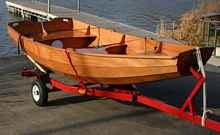 |
CLC Passagemaker, Northern Tool trailer |
Jim launched his Passagemaker pram into a lake near
Whitewater WI in late November 2009. He was thoroughly impressed
with the boat, and enjoyed the opportunity to row it around the
lake before the snow flew.
In particular, the 90-pound boat seemed to float like a leaf
in the calm water, and was a delight to row, being very responsive
under oars.
 |
The Passagemaker floats like a leaf |
Jim will build the mast and dagger board over the winter of 2009-2010,
and bought the sail and rigging from Chesapeake Light Craft. In
the meantime, until they’re built, he will use an old trolling
motor with the boat. “Spring”, he says, “can’t
come soon enough for a first sail.”
Jim is enthusiastic about his experience. “I can only say
great things about the kit”, he says. “EVERYTHING
went just as the plans and instructions stated. CLC did an outstanding
job on delivering exactly what I wanted, and Kim Grunow of the
Rock River Canoe Company provided excellent support and encouragement.
I can say without hesitation that I would buy another plan or
kit from CLC, indeed they would be the very first place that I
would consider!”
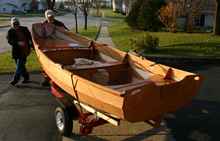 |
Spring can’t come soon enough as the
Passagemaker heads for the barn for the wnter! |
*****

|

